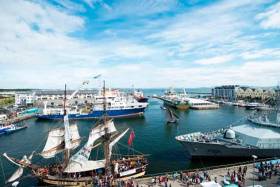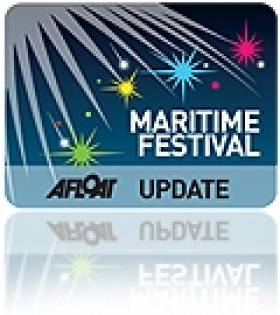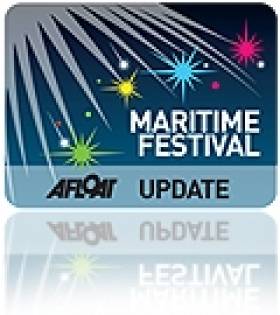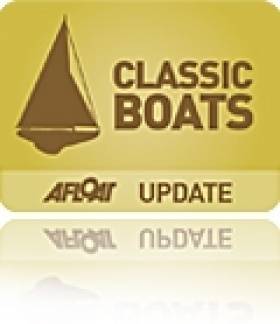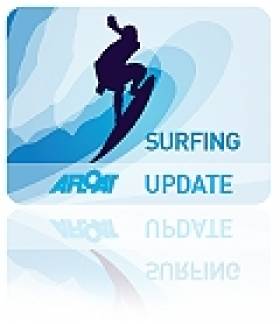Displaying items by tag: Festival
This year's Spanish Armada Festival returns next monthand will be the 14th consecutive year that the annual event has taken place in Co. Sligo.
The event runs from Thursday 14th to Saturday 17th September and this will involve four locations: Grange, Streedagh, Cliffoney and in Sligo town.
Plenty of events are lined up reports the Sligo Champion over the course of the four-day festival covering arts, history, culture, music and the spoken word.
What is at the focus of the festival is of the three Spanish Armada ships that sank at Streedagh beach during storms on 21st September, 1588.
The armada wrecks, Afloat highlights comprise of the La Lavia, Santa María de Visón and La Juliana which got caught up in The Great Gale. This once in a generation storm resulted in the deaths of approximately 1,100 Spanish lives, including sailors and soldiers who perished at Streedagh.
Since the festival was established in 2009, the locals of Grange have welcomed Spanish visitors from far and wide to Sligo for the annual commemoration.
On the opening day of this year's festival there will feature a bus tour to Killybegs Harbour in neighbouring Co. Donegal. The tour to the harbour is to include a Spanish Navy ocean patrol vessel the Centinela (P-72) which is to make a special visit as part of the festival.This is where a reception to mark the Armada is to be attended by officers and ratings of the Centinela.
The Serviola-class patrol vessel, Afloat notes was built in 1990 by the Spanish shipbuilding group, Navantia which is part of Team Resolute, a UK consortium including Harland & Wolff, that is to assemble in building a trio of Fleet Replenishment Support Ships for the UK Ministry of Defence.
As for the festival's main event, this will be the Remembrance Parade which will be held on Saturday, the final day of events.
The public are invited to walk a trail from Streedagh to the Armada Monument so as to pay tribute to those lost in the tragedy, one of the greatest maritime tragedies to have taken place on the Irish coast.
More here from the regional newspaper.
Galway Business Backs Seafest Maritime Festival
Businesses across Galway and the region are giving their support to SeaFest 2017, with festival activities extending from Galway Harbour to The Latin Quarter and Salthill.
SeaFest 2017 is Ireland's national maritime festival and will include a variety of marine-themed activities and attractions to celebrate the sea from 30 June to 2 July 2017.
Dr Peter Heffernan CEO of the Marine Institute said the involvement of businesses across Galway and the region is vital to the success of SeaFest 2017.
"The marine sector is of major value to the Irish economy and coastal communities and offers significant potential for growth. It is essential for businesses, organisations and communities connected with our ocean to be part of SeaFest," Dr Heffernan said.
For the first time, SeaFest will welcome the contribution of the Western Development Commission (WDC) to the 2017 event.
"The WDC are delighted with the opportunity to participate in SeaFest," said Ian Brannigan CEO of the WDC. "At SeaFest we are setting out to showcase businesses in the West of Ireland who take their inspiration from Ireland's ocean. Mr Brannigan said.
The Galway Chamber of Commerce will also support SeaFest 2017 by working with businesses across Galway, particularly The Latin Quarter Galway and Salthill, to develop a programme of activities.
"Salthill offers stunning views of Galway Bay, and is the ideal location to feature water sports and hold family-friendly activities along the shore," Dr Heffernan said. "SeaFest is also an opportunity to highlight the host of quality eateries in The Latin Quarter Galway, including some of the city's finest seafood restaurants serving locally sourced produce."
As well as the three-day festival, a range of industry events will be held as part of SeaFest 2017. National and international delegates will attend Our Ocean Wealth Summit on 30 June at NUI Galway. Digital Ocean: Ireland's Marine Engineering and Technology Conference and the Marine Industry Awards will take place on 29 June. A Marine Trade Show will also be held at NUI Galway on 29 and 30 June, to run in parallel with the Our Ocean Wealth Summit and Digital Ocean events.
SeaFest is co-ordinated by the Marine Institute, on behalf of the Marine Coordination Group.
Kilmore Quay Literary Festival Attracts Wexford Literary Scene
Billy Roche, Cat Hogan and Paul O’Brien are among an impressive list of Wexford literary names already confirmed for the inaugural Write By The Sea, a festival of writing and reading set to take place in Kilmore Quay, Co Wexford from September 23 to September 25, 2016.
A packed schedule of workshops, readings, conversations and interviews will also feature such established local writers as A.M. Cousins, Margaret Galvin, Jackie Hayden, Margaret Hawkins, Daithi Kavanagh, Jim Maguire, Peter Murphy and Fiona O'Rourke.
Billy Roche will read from his writings as well as delivering a workshop on Playwriting. Margaret Hawkins will talk about Journalism, and Paul O’Brien will be interviewed on-stage about his best-selling trilogy of novels Blood Red Turns Dollar Green.
A.M. Cousins will direct a workshop on writing for radio, Margaret Galvin’s workshop will focus on participants’ personal memories and stories , and Jackie Hayden will talk about how he discovered the Welsh poet Dylan Thomas through The Beatles and Bob Dylan.
Cat Hogan will discuss what writers need to do after they’ve completed a new work, and she’ll also talk about her acclaimed debut novel They All Fall Down. Novelist and spoken word performer Peter Murphy is scheduled to read from his works, as well as offering invaluable advice for aspiring writers. Daithi Kavanagh will explore the world of e-books, Jim Maguire will hold a workshop on “the journey home’ and Fiona O’Rourke will explore ways of kick-starting your writing creativity.
Maritime Culture At This Year’s Cork Harbour Festival
Get ready for a carnival of maritime culture at this year’s Cork Harbour Festival, 4th-12th of June. Now in its second year, the festival presents a fresh perspective on everything the Harbour has to offer through a programme of over 50 unique and fun-filled events.
The festival begins with the Ocean to City – An Rás Mór on Saturday June 4th. This year marks the 12th edition of this iconic race, which sees over 150 hardy crews take to the water for the gruelling 28km route from Roche’s Point to Cork’s city centre. As a premier event in Irish and international rowing, the Ocean to City attracts crews from all over Europe. The race features over 30 different types of craft, from traditional Irish currachs, to Chinese dragon boats and stand-up paddle boards! Spectators can soak up the colour and festivities in many places along the race route, including Cobh, Monkstown, Passage West and Blackrock. Follow the race route by bike with the Harbour Pedal, bring a picnic to Passage, or enjoy thrilling acrobatics from Funky Fidelma and street performers at the finish line. Mingle with the many crews and treat yourself to a range of foodie delights at the festival market.
Cork Harbour Open Day on June 5th offers kayaking, surfing and coasteering tasters in East Cork, family adventure in Spike Island, crab fishing fun in Cobh, and historical re-enactments at Camden Fort Meagher. Turn a weekend stroll into a bird watching walk, get behind the scenes of the Irish Navy with a naval ship tour, or discover the work of ocean energy researchers at the MaREI Centre, Ringaskiddy.
Festival week continues to push the boat out, with event highlights including:
· Rocket Man’s Paddling Pantry: Jack Crotty a.k.a. The Rocket Man mixes his love of good food and fresh flavours with a kayaking adventure. Circumnavigate the city channels and enjoy Cork’s built heritage while being treated to a tasty lunch!
· River Runner and Green Drinks: The Opera House plays host to this moving documentary portrait of the River Lee from source to sea. The film uncovers the secrets of its oldest inhabitant, the Wild Atlantic Salmon, and the river’s unique forest delta, known locally as the Gearagh. The film is followed by Cork Environmental Forum’s ‘Green Drinks’, a chance to meet and chat with local and national environmental organisations.
· Morgenster Tall Ship: Visit the Dutch sail training ship ‘Morgenster’ during her stay in the city. The Morgenster will be docked in Cork on June 11th and Cobh June 12th.
· Lunchtime Lectures: The festival teams up with UCC’s History Department to bring an engaging series of mid-day lectures at St. Peter’s Church. Learn about the history of the Bordeaux wine trade with Ireland, the Hapsburg’s visit to Ireland in 1518, and the story of the Royal Navy during the 1916 Rising.
· Festival Cruise: Enjoy a summer’s evening cruise through Cork Harbour before mooring up for a tasty meal in Crosshaven
· Boats and Bites: The festival’s midweek celebration of boats and the freshest bites will include a seafood market and free taster sessions aboard a currach, dragon boat, powerboat and more!
· Night-time Kayak: A unique opportunity to paddle the city by night and explore Cork from a whole new angle.
· SUPing in the City: Dip your toes in with kayaking and Stand-Up Paddle Boarding taster sessions at the Lee Fields in Cork City.
Cork Harbour Festival aims to bridge the distance from city to sea through a programme that encourages people to discover the region. Festival Director Donagh MacArtain says, “The festival highlights the importance of the River Lee and Cork Harbour as a natural and cultural resource, and celebrates the communities and organisations at the heart of it. This year’s programme has something for everyone, whether you like to get active and get outdoors, are a regular or first time ‘boatie’, want fresh ways to enjoy some fun with the family, or want to soak up the harbour’s history and folklore.’’
Cork Harbour Festival is organised by Meitheal Mara, the community boatyard, training centre and charity located in the heart of Cork City. The Festival is sponsored by Cork City Council, Cork County Council, Port of Cork, Failte Ireland and MaREI, and made possible with the help of dozens of Event Partners and hundreds of volunteers.
Clondra Hosts Canoeing Club Championships Next Month
#Canoeing - Richmond Harbour on the Royal Canal in Clondra, Co Longford will be the site of the Canoeing Ireland Club Championships over the weekend of 16-17 April.
As the Longford Leader reports, the event coincides with the second annual Longford Blueway Festival taking place in the town and surrounds.
Up to 500 competitors and their supporters are expected in Clondra for the national canoeing contest which joins a number of events scheduled for the weekend, including cycles and walks of the 10km Camlin Loop of the Shannon Blueway that was launched last year, as previously reported on Afloat.ie.
There will also be public 'taster sessions' on the water for those curious about canoeing whether for sport or recreation. Details are available on the Canoeing Ireland website.
The Longford Leader has more on the story HERE.
#rathlin – The Rathlin Sound Maritime Festival was celebrating its most successful run in the Festival's history, until high winds affected the crossings on the Rathlin Sound, according to Causeway Coast and Glens Tourism Officer, Caroline Carey.
It was estimated that this year's Festival opened to a record number of visitors and tourists to Ballycastle, with thousands of tourist enquiries leading up to and including the first weekend.
Caroline Carey, Tourism Officer at Causeway Coast and Glens explains, "It was just unfortunate that there were high winds on the Sunday 31 May which stopped many people going to Rathlin and enjoying the many planned festivities.
"Despite that, his year we were over the moon with the amount of interest in our local area. Figures are yet to be finalised, but we were confident that the Rathlin Sound Maritime Festival would have drawn in nearly 10,000 people to the area."
"We've had some amazing events on in both Rathlin and Ballycastle, which have really brought both of our communities together. It all kicked off on Friday with the Blessing of the Boats, which was absolutely beautiful. After the serene ceremony, Saturday saw a host of maritime events, with our very own jet man, power boating and kayaking, followed by some fabulous cookery demonstrations and art and craft events on Sunday at the Ballycastle Market.
"Our stand-out events include the fabulous Frances Black concert at the Marine Hotel on Sunday 24th, which was a resounding success, it was a real treat to have Frances performing. Frances's daughter, Aoife Scott also performed, and both were delighted to be back in the area and really enjoyed their time here! On Wednesday 27th, Trevor Robertson, the world renowned record breaking sailor also stopped by Rathlin Island, delivering a talk on his times spent 'overwintering' and inviting the locals to come on board his famous 'Iron Bark'.
"Despite the bad weather, the events on Sunday were very successful, it's just such a shame that some people couldn't make it over for them! The Festival celebrated our passion for the sea, local culture, heritage and history, and we finished with Rathlin's 'Big Lunch', music from 'Runabay' and our 'Living Seas' event on Sunday 31st May."
Sponsored by Tourism Northern Ireland, Malin Waters, Fair Head Tidal and Rathlin Island Boat House, the festival is renowned for its musical events, celebration of local produce and, of course, the many varied maritime activities.
Michael Cecil, Chair of Rathlin Community and Development Group explained: "inclement weather reduced the numbers somewhat but even that was a reminder that we are all very closely connected to nature. Seeing so many traditional boats , meeting so many like minded people from all over this earth and hearing so much traditional music over ten days was something very special."
"We would like to say a huge thank you to all who have come out and supported the Festival and ensured that this year was a huge success up until the Sunday. This was a team effort, and it wouldn't have been possible without the help from our sponsors and the Council Harbour & Tourism Section, Ballycastle Community Development Group, the Rathlin Development & Community Association, and the Ballycastle Chamber of Commerce and Industry," concluded Caroline Carey.
Classic Planes Debut At Bray Air Display This Summer
#Festivals - If you enjoyed last year's FlightFest on the River Liffey, mark Sunday 20 July on your calendars - as organisers have announced details of this year's Bray Air Display.
The Hunter, the Sabre, the Yaks and the Vampires are all set to make their Bray aerial debut at Ireland’s largest free air show, organised in association with Bray Summerfest and the Irish Aviation Authority.
The free family event attracted a record-breaking 85,000 spectators last year, with similar numbers expected again this summer.
Team Yakovlevs - or the Yaks, as they are affectionately known - are among those making their Bray debut, having entertained millions of people around the world with their precision formation flying.
Their Super 52 two-seater planes will be followed in close formation by three single seater Yak 50 planes.
The Vampires, piloted by Kenneth Aarkvisla and Per ‘Smiley’ Stromme, will be flying their jet fighters from the Second World War, capable of reaching top speeds of 548 miles per hour.
Meanwhile, pilot Mark Linney will be roaring over the skies of Bray in the Sabre, an American fighter jet best known for its high speeds and loud engines.
And the Hunter, flown by Jonathan Whaley, is a British-made fighter from the 1950s, renowned for its loud engines, manoeuvrability and breakneck speeds.
Display director Sé Pardy from Simtech Aviation said: “Once again, Ireland is attracting world-class pilots and aircraft to Bray for the country’s biggest free air show on 20 July.
"For this year’s programme, we’re introducing vintage aircraft, extreme formation flying and search and rescue demonstrations, bringing excitement, aerial acrobatics and thrills to the East Coast.
"We have several new acts making their debut, but we will also be welcoming crowd favourites back to Bray, with aerial action to entertain the whole family.”
Introduced in 1949, the famous MIG 15 was developed by the Soviet Union and was the only aircraft to face the Sabre in combat. This loud, vintage plane will also be making its first appearance at Bray.
The S-92 helicopter, operated by the Irish Coast Guard, will also be welcomed for the first time to Bray. Equipped for dedicated search and rescue (SAR) operations, it services Ireland’s offshore islands and provides rescue cover from Cork to Galway.
Other aircraft making their debut in July include the Stearman 75 and the Decathlon, a two-seater sports plane.
The Bray Air Display is just one of the highlights in the annual Bray Summerfest programme, which runs from 5 July to 14 August 14 subject to licence.
Further aircraft will be announced for the display over the coming weeks, and due to the large crowds expected on the day, spectators are strongly advised to use DART, Dublin Bus and other public transport services as parking restrictions will be in place.
For more on the day's events visit BrayAirDisplay.com.
#STBFestival. – Weigh your anchor, fill your sails and get ready for the 2014 Aberdeen Asset Management Scottish Traditional Boat Festival. Thousands of visitors are expected to attend the 21st annual festival which will be taking place in Portsoy, Aberdeenshire from June 27-29th 2014.
Scotland's leading celebration of maritime and cultural heritage is one of the key events in The Year of Homecoming, with the theme reflected throughout the festival programme. The event will showcase the best in Scotland's maritime, crafts, food, drink, music and dance, with a special emphasis on boat building, restoration and sailing.
Traditional wooden boats from all over the UK and beyond will congregate in the historic 17th century Portsoy harbour. Visitors will be able to learn how to sail a coracle, climb aboard restored fishing vessels, and see the crews of the St Ayles Skiffs battle it out on the open seas in the annual regatta. This year will also see the official opening of the PORT Boatshed, a community boat building workshop which allows training and restoration to be undertaken.
Aberdeen Asset Management Scottish Traditional Boat Festival Chair, Roger Goodyear, says, "The Festival has a great programme that offers a fantastic traditional maritime experience. Each year our Festival continues to grow stronger and draw in huge crowds- the small town usually only has a population of 2000 people, and this rises to an incredible 16,000 people over the weekend of the Festival.
"Now in its 21st year, we hope to continue to build on its enviable reputation for showcasing the very best in traditional maritime festivities with a range of craft, food, drink, music and dance events. What started as a small community celebration to mark the 300th anniversary of Portsoy harbour has grown to become recognised by VisitScotland as one of the region's flagship tourism events, which is a fantastic boost."
The music programme will feature the very best of traditional music including popular Scottish folk singers and local favourites. The music line up this year reflects the Year of Homecoming by bringing together local musicians and performers from around the world including headliners RURA, festival favourites De Kinkels from the Netherlands and Slogmaakane, fabulous shanty singers from Norway.
The festival craft marquee is set to attract artists and craft workers from across Scotland, while food and drink from the North-east's larder will on show at the Wally Green Food Fayre.
Caroline Packman, Homecoming Scotland Director, says, "Homecoming places the spotlight on our greatest assets and celebrates all that's great about our country, so it's only fitting the Scottish Traditional Boat Festival is part of the packed Homecoming programme of events. Scotland is the perfect stage for major cultural events and the Boat Festival provides a truly enchanting example of the regions rich heritage and culture. Whether you are interested in crafts, historic vessels, boat races or it's simply a day out with the family - there's truly something for everyone at Portsoy."
For more information about the Festival and to buy tickets visit www.stbfportsoy.com.
An adult day ticket to the festival costs £8, children aged five to 18 and concessions are £5. Adult weekend tickets are priced at £12 and children and concessions at £8. There are also family tickets available which allow entry for two adults and three children for £25 for a day ticket and £35 for a weekend. Children under five go free. Car parking is available and costs £2, with the price including a brochure.
Galway Oyster Festival Gets Under Way
#Galway - Today 26 September marks the start of the 2013 Galway International Oyster & Seafood Festival, with a full four days of gastronomic goodness in the City of the Tribes.
Probably the most internationally recognised Irish festival after St Patrick's Day, and the world's longest running oyster festival, the weekend includes a whole host of events to enjoy, from seafood trails and oyster hot spots to the oyster shucking contests – including the Oyster 'Olympics', the World Oyster Opening Championship.
Alongside local food producer tours, some of Galway's best restaurants will hold foodie talks and tasting events, and will represent in the intimate 'food village' at the Festival Marquee.
On Saturday night, a sold-out Mardi Gras-style gala masquerade will parade through the streets of Galway.
And on Sunday, the Tribal Oyster Feast Off oyster eating competition will take place along with family activities, live music, cooking demonstrations, a 'Hot Oyster Awards' cooking challenge and more.
Established in 1954, the Galway International Oyster & Seafood Festival has welcomed over half a million visitors and consumed more than 3 million oysters – washed down with champagne and stout while listening to some of the best musicians in Ireland.
For more information on the festival, follow on Twitter @galwayoyster
Shore Shots Film Fest Is 'Roaring Success'
#Surfing - Ireland's first ever surfing themed film festival has been hailed as a "roaring success" all round, according to surf website Magicseaweed.
The Shore Shots Irish Surf Film Festival - which took over the Light House Cinema and the Generator Hostel in Dublin's Smithfield last weekend, as previously reported on Afloat.ie - featured the Irish premieres of five new big-screen surfing films, including the 3D epic Storm Chasers.
But it was the Short Film section attracted the most excitement and plaudits over the two days, with an edit of Fergal 'Ferg' Smith - tackling the biggest and best waves Ireland has to offer over two years - claiming top prize in the category.
Others of note in the shortlist include bodyboarder Peter Clyne and some truly exciting POV footage from Dylan Scott - shot with a single GoPro and put together on the smallest of budgets.
North Of Nowhere from Peter Clyne - Outer Cells on Vimeo.
trendynewatrocity2 - By Dylan Stott from MSW on Vimeo.
Magicseaweed has much more on happenings from the festival HERE.


























